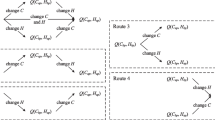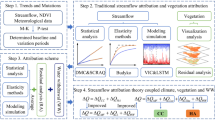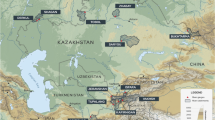Abstract
Attribution analysis is widely used to assess the impacts of environmental change on water resources. However, the chain of uncertainty involved is often not given sufficient attention, which can lead to inaccurate assessments and poor responses. This study aims to build a framework for attribution analysis of streamflow changes considering uncertainties. Under this framework, a large-scale Soil and Water Assessment Tool (SWAT) model is established and calibrated using streamflow data collected from key stations, with model parameter posterior distributions obtained from the Differential Evolution Adaptive Metropolis (DREAM) algorithm. A multi-route attribution analysis to attribute streamflow change to the influence of driving factors is performed. The developed methodology is applied to a case study of the Upper Yangtze River Basin (UYRB) in China. Results reveal that: (1) Streamflow decreases significantly in the UYRB with varying characteristics at small scale. (2) Precipitation plays the most dominate role in driving streamflow changes with the largest uncertainty, while other driving factors behave differently in various river basins. (3) Changes in precipitation, maximum temperature, wind speed and land use/ cover change (LUCC) tend to decrease streamflow, while changes in minimum temperature and relative humidity tend to increase streamflow in the UYRB. These findings can help enhance the understanding of the influence of climate change and human activities on streamflow, and provide further insights into the adaptive water resources management.






Similar content being viewed by others
Availability of Data and Materials
All data and materials are available from the corresponding author on request.
References
Ahmadi M, Bozorg-Haddad O, Loaiciga HA (2015) Adaptive reservoir operation rules under climatic change. Water Resour Manag 29(4):1247–1266. https://doi.org/10.1007/s11269-014-0871-0
Barnett TP, Adam JC, Lettenmaier DP (2005) Potential impacts of a warming climate on water availability in snow-dominated regions. Nature 438(7066):303–309. https://doi.org/10.1038/nature04141
Hall JW, Grey D, Garrick D, Fung F, Brown C, Dadson SJ, Sadoff CW (2014) Coping with the curse of freshwater variability. Science 346(6208):429–430. https://doi.org/10.1126/science.1257890
Hawkes CV, Waring BG, Rocca JD, Kivlin SN (2017) Historical climate controls soil respiration responses to current soil moisture. P Natl Acad Sci USA 114(24):6322–6327. https://doi.org/10.1073/pnas.1620811114
Hrachowitz M, Clark MP (2017) HESS Opinions: The complementary merits of competing modelling philosophies in hydrology. Hydrol Earth Syst Sc 21(8):3953–3973. https://doi.org/10.5194/hess-21-3953-2017
Hutchins MG, Abesser C, Prudhomme C, Elliott JA, Bloomfield JP, Mansour MM, Hitt OE (2018) Combined impacts of future land-use and climate stressors on water resources and quality in groundwater and surface waterbodies of the upper Thames river basin, UK. Sci Total Environ 631–632:962–986. https://doi.org/10.1016/j.scitotenv.2018.03.052
Jiang C, Xiong LH, Wang DB, Liu P, Guo SL, Xu CY (2015) Separating the impacts of climate change and human activities on runoff using the Budyko-type equations with time-varying parameters. J Hydrol 522:326–338. https://doi.org/10.1016/j.jhydrol.2014.12.060
Leta OT, Nossent J, Velez C, Shrestha NK, van Griensven A, Bauwens W (2015) Assessment of the different sources of uncertainty in a SWAT model of the River Senne (Belgium). Environ Modell Softw 68:129–146. https://doi.org/10.1016/j.envsoft.2015.02.010
Marvel K, Bonfils C (2013) Identifying external influences on global precipitation. P Natl Acad Sci USA 110(48):19301–19306. https://doi.org/10.1073/pnas.1314382110
Moriasi DN, Arnold JG, Van Liew MW, Bingner RL, Harmel RD, Veith TL (2007) Model evaluation guidelines for systematic quantification of accuracy in watershed simulations. T Asabe 50(3):885–900. https://doi.org/10.13031/2013.23153
Nazemi A, Zaerpour M, Hassanzadeh E (2020) Uncertainty in bottom-up vulnerability assessments of water supply systems due to regional streamflow generation under changing conditions. J Water Res Plan Man 146(2):04019071. https://doi.org/10.1061/(ASCE)WR.1943-5452.0001149
Prowse TD, Beltaos S, Gardner JT, Gibson JJ, Granger R, Leconte R, Peters DL, Pietroniro A, Romolo LA, Toth B (2006) Climate change, flow regulation and land-use effects on the hydrology of the Peace-Athabasca-Slave system; Findings from the Northern Rivers Ecosystem Initiative. Environ Monit Assess 113(1–3):167–197. https://doi.org/10.1007/s10661-005-9080-x
Renner M, Seppelt R, Bernhofer C (2012) Evaluation of water-energy balance frameworks to predict the sensitivity of streamflow to climate change. Hydrol Earth Syst Sc 16(5):1419–1433. https://doi.org/10.5194/hess-16-1419-2012
Sankarasubramanian A, Vogel RM, Limbrunner JF (2001) Climate elasticity of streamflow in the United States. Water Resour Res 37(6):1771–1781. https://doi.org/10.1029/2000WR900330
Sharma TC (1985) Stochastic-models applied to evaluating hydrologic changes. J Hydrol 78(1–2):61–81
Sun Y, Tian FQ, Yang L, Hu HP (2014) Exploring the spatial variability of contributions from climate variation and change in catchment properties to streamflow decrease in a mesoscale basin by three different methods. J Hydrol 508:170–180. https://doi.org/10.1016/j.jhydrol.2013.11.004
Tomer MD, Schilling KE (2009) A simple approach to distinguish land-use and climate-change effects on watershed hydrology. J Hydrol 376(1–2):24–33. https://doi.org/10.1016/j.jhydrol.2009.07.029
Teuling AJ, de Badts EAG, Jansen FA, Fuchs R, Buitink J, van Dijke AJH, Sterling SM (2019) Climate change, reforestation/afforestation, and urbanization impacts on evapotranspiration and streamflow in Europe. Hydrol Earth Syst Sc 23(9):3631–3652. https://doi.org/10.5194/hess-23-3631-2019
Vrugt JA (2016) Markov chain Monte Carlo simulation using the DREAM software package: Theory, concepts, and MATLAB implementation. Environ Modell Softw 75:273–316. https://doi.org/10.1016/j.envsoft.2015.08.013
Vrugt JA, Ter Braak CJF, Clark MP, Hyman JM, Robinson BA (2008) Treatment of input uncertainty in hydrologic modeling: Doing hydrology backward with Markov chain Monte Carlo simulation. Water Resour Res 44:W00B09. https://doi.org/10.1029/2007WR006720
Vrugt JA, ter Braak CJF, Diks CGH, Robinson BA, Hyman JM, Higdon D (2009) Accelerating markov chain monte carlo simulation by differential evolution with self-adaptive randomized subspace sampling. Int J Nonlin Sci Num 10(3):273–290. https://doi.org/10.1515/IJNSNS.2009.10.3.273
Wan XY, Hua LJ, Yang ST, Gupta HV, Zhong PA (2018) Evaluating the impacts of a large-scale multi-reservoir system on flooding: Case of the Huai River in China. Water Resour Manag 32(3):1013–1033. https://doi.org/10.1007/s11269-017-1852-x
Wang DB, Hejazi M (2011) Quantifying the relative contribution of the climate and direct human impacts on mean annual streamflow in the contiguous United States. Water Resour Res 47:W00J12. https://doi.org/10.1029/2010WR010283
Wang ML, Zhang Y, Lu Y, Gong XL, Gao L (2021) Detection and attribution of reference evapotranspiration change (1951–2020) in the Upper Yangtze River Basin of China. J Water Clim Change 12(6):2624–2638. https://doi.org/10.2166/wcc.2021.011
Wang XX (2014) Advances in separating effects of climate variability and human activity on stream discharge: An overview. Adv Water Resour 71:209–218. https://doi.org/10.1016/j.advwatres.2014.06.007
Ye XC, Zhang Q, Liu J, Li XH, Xu CY (2013) Distinguishing the relative impacts of climate change and human activities on variation of streamflow in the Poyang Lake catchment, China. J Hydrol 494:83–95. https://doi.org/10.1016/j.jhydrol.2013.04.036
Zhai R, Tao FL (2017) Contributions of climate change and human activities to runoff change in seven typical catchments across China. Sci Total Environ 605:219–229. https://doi.org/10.1016/j.scitotenv.2017.06.210
Zhang Y, Wang ML, Chen J, Zhong PA, Wu XF, Wu SQ (2021a) Multiscale attribution analysis for assessing effects of changing environment on runoff: case study of the Upstream Yangtze River in China. J Water Clim Change 12(2):627–646. https://doi.org/10.2166/wcc.2020.155
Zhang Y, Wu XF, Wu SQ, Dai JY, Yu L, Xue WY, Wang FF, Gao A, Xue C (2021) A framework for methodological options to assess climatic and anthropogenic influences on streamflow. Front Env Sci 9:765227. https://doi.org/10.3389/fenvs.2021.765227
Zhang Y, Yu L, Wu SQ, Wu XF, Dai JY, Xue WY, Yang QQ (2021c) A framework for adaptive control of multi-reservoir systems under changing environment. J Clean Prod 316:128304. https://doi.org/10.1016/j.jclepro.2021.128304
Funding
This work was supported by the National Natural Science Foundation of China (Grant No. 52209032), and the Natural Science Foundation of Jiangsu Province, China (Grant No. BK20200160).
Author information
Authors and Affiliations
Contributions
Conceptualization: MW, YZ; Methodology: MW, YZ, YL; Formal analysis and investigation: MW, YL, LG; Writing - original draft preparation: MW, YL, LG; Writing - review and editing: MW, YL, YZ, LG, LW; Funding acquisition: YZ; Resources: YZ; Supervision: YZ.
Corresponding author
Ethics declarations
Ethical Approval
Not applicable.
Consent to Participate
Not applicable.
Consent to Publish
Not applicable.
Competing Interests
The authors declare that they have no competing interests.
Additional information
Publisher's Note
Springer Nature remains neutral with regard to jurisdictional claims in published maps and institutional affiliations.
Supplementary Information
Below is the link to the electronic supplementary material.
11269_2022_3396_MOESM1_ESM.pdf
Posterior distributions of parameters in basins of the UYRB. The top 10 sensitive parameters in 8 basins are shown in each row, whose sensitivity decreases from left to right. (PDF 225 KB)
Rights and permissions
Springer Nature or its licensor (e.g. a society or other partner) holds exclusive rights to this article under a publishing agreement with the author(s) or other rightsholder(s); author self-archiving of the accepted manuscript version of this article is solely governed by the terms of such publishing agreement and applicable law.
About this article
Cite this article
Wang, M., Zhang, Y., Lu, Y. et al. Attribution Analysis of Streamflow Changes Based on Large-scale Hydrological Modeling with Uncertainties. Water Resour Manage 37, 713–730 (2023). https://doi.org/10.1007/s11269-022-03396-7
Received:
Accepted:
Published:
Issue Date:
DOI: https://doi.org/10.1007/s11269-022-03396-7




